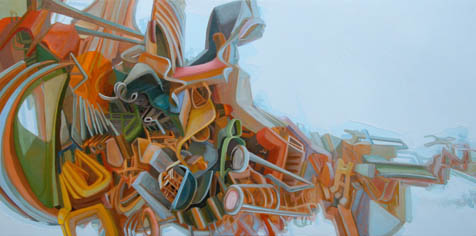Julie Rofman. At Gallery Ocho.
Shows through January 19.

To dig into the details of Julie Rofman’s paintings is to embark on a fantastic excavation. Piles of imaginary detritus are heaped together to form complex landscapes. Twisting shapes, both abstract and figurative, collapse into unusual architectural mounds. For Rofman, these metaphorical junkyards represent a flip side to our reality, a kind of fourth dimension where the remainders of our mass-consumption culture-pieces of colored glass fused together, islands of plastic floating in the ocean, and cast-off household goods-morph together in curious conglomerations. Somehow, Rofman transforms this cacophony of shapes, colors, and lines into symphonic compositions.
Like the works of the Surrealists who have influenced her, Rofman’s paintings have an eerie, futuristic feel, their subjects existing in the intersection between imagination and reality. In these landscapes, the law of gravity is non-existent, objects are only semi-recognizable, and perspectives are exaggerated. In “Conglomerate,” for example, brightly colored artificial objects fuse together in a sculpture of orbital debris. It is as if Rofman is visualizing a collective premonition of a possible future, where overflow and overabundance encroach upon the open spaces of ocean, air, and land.
Her subject matter is not limited to physical objects; it also applies to virtual flotsam and jetsam, like conversations passing between phone towers, or satellite signals crossing each other in space. “Here Too” is a visual rendering of this type of interaction, where a conversation about over-accumulation is represented by slick metal sculptures on opposite sides of the canvas. In this context, Rofman’s work is entirely appropriate for hanging on the walls of businesses like Google, where she was commissioned to create a mural. In fact, Rofman is most successful in projecting her envisioned spaces when her pieces are in large-scale format, so that the minutiae of her imaginings are easier to investigate and get lost in. Her smaller works lack the same intensity of composition because the mechanisms of her technique get lost in diminution. She is a painter, but Rofman is truly an architect at heart, constructing imagined worlds with meticulous measure and inviting us along for the tour.



